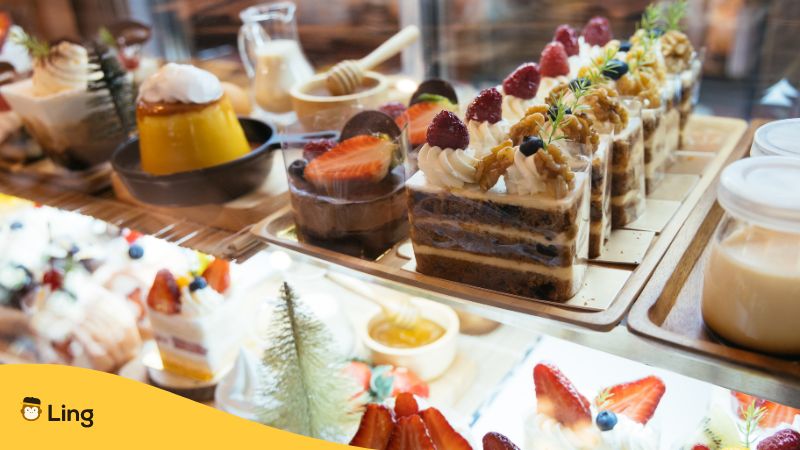Estonia may be among the hardest language to learn, but would it inspire you to know that this country in the Baltic region has the most delicious Estonian desserts? You see, this country possesses a diverse culinary culture shaped by its history, natural resources, and cultural influences. From hearty stews to delicate pastries, Estonian food offers a range of flavors tied to its landscapes. Let’s explore the foods meant for the sweet-toothed souls that you must give a try when visiting Estonia.
Discovering Classic Estonian Desserts
Let’s begin with the list of sweets that you must have while learning new words and phrases from this country with a rich culinary culture:
Kalev Confections
Kalev Confections, the prominent chocolate factory in Estonia, has won the hearts of locals and tourists with its delectable offerings. Among these treats, one standout is white chocolate infused with crispy rice and juicy blueberries. There’s also a range of seed-infused chocolates, like pumpkin, and other creative but delicious flavors introduced regularly. This collection pays homage to Estonia’s national folklore, featuring depictions and names from the legendary Kalevipoeg tale.
Berry Semolina Mousse
This is a fondly remembered dish from school cafeterias and holds a special place in the memories of many locals. The process involves cooking semolina in tart redberry or blackcurrant juice along with sugar. Once done, it transforms into a luscious pudding, served cold with fresh milk.
Curd Cheese Indulgences
Traditional curd snack cheese treats, covered in a thin layer of chocolate, are much-loved by Estonians. Often bought rather than made at home, these confections come in various options, including caramel or jam-filled varieties, and are easily found in local stores.
Vastlakukkel
Combining a bread bun with whipped cream, this confection, known as “vastlakukkel” in Estonia, is a hit alongside similar treats in the north. Sliced open, filled with almond paste, and generously topped with whipped cream, it’s a highlight during the “Vastlapäev” celebration in February and March, resembling “Shrove Tuesday.”
Bread Soup
From regions with Russian cuisine influence, bread soup is a unique dessert. Its appearance might not impress since the bread soup is made from aged black bread, raisins, and fruit kissel, but it has an unforgettable taste. It resembles a blend of bread, root beer, fruit, and simple delight.
Kama Bliss
Kama is a mixture of toasted and ground grains like peas, wheat, rye, and barley, combined with kefir or sour milk. Fresh berries often enhance it, but the preferred version is kama mousse. It’s a creamy mixture of whipped cream, sugar, and Kama, topped with buckthorn or blueberries.
Crisp Wafers
Unlike the fluffy waffles of Belgium and the USA, Estonian waffles are thin and crispy. Rolled into tubes or shaped into cones, they offer a delightful base for various fillings or a sprinkle of powdered sugar or cocoa powder. You can also add fresh berries and drizzle with melted dark chocolate when serving.
Creamy Curd Harmony With Kissel
With different flavors of curd available, making kissel is a common skill in Estonia. An easy and cost-effective way to satisfy the taste buds, this dessert offers a range of flavors.
Rhubarb Pies
The tart pink stalks of rhubarbs are used in various creations, with rhubarb pie being a favorite. Made from sugar, flour, butter, eggs, and sour cream, it balances the tanginess with sweetness.
Caramel Kissel And Milk Kissel Bliss
You can get this uncomplicated dessert at a local grocery store. While it’s among the easy-to-make desserts in Estonia, you may want it bought than done. You can choose to enjoy this popular dessert on its own or paired with toppings like jam.

The Global Appeal Of Estonian Desserts
As Estonians have spread across the world, they’ve taken their cherished recipes and sweet traditions with them. Whether in distant lands or close-knit communities, Estonian expatriates have preserved their dessert heritage, ensuring that the tastes of home remain alive.
Estonian dessert culture has transcended borders, finding a place in cafés and restaurants around the globe. From bustling cities to cozy corners even in Asia, these establishments offer a taste of Estonia’s sweet traditions. With offerings ranging from classic Kama to innovative fusion creations, these eateries provide a taste so familiar and loved by the Estonian diaspora.
The strength of Estonian dessert culture lies in its ability to adapt and evolve while staying connected to tradition. Across continents, communities are embracing their culinary heritage and infusing local ingredients, adding a global twist to beloved recipes. This preservation and adaptation not only honor the past but also contribute to the evolving story of Estonian dessert culture on a global scale.
Beyond their deliciousness, Estonian desserts hold stories, values, and memories of past generations. They serve as a conduit to preserving cultural heritage, fostering unity and identity among Estonians, both at home and abroad. By indulging in these desserts, we celebrate not only culinary artistry but also the collective spirit of Estonia itself.

Why Not Learn Some Estonian Words To Praise The Food?
While you are all geared up to learn Estonian fast (always pronounce long Rs), here’s a peek at some phrases you can use to praise local cooks or chefs:
| English | Estonian |
| Delicious | Maitsvad |
| Exquisite | Ekskviisid |
| Irresistible | Vastupandamatud |
| Culinary Delights | Kulinaarsed naudingud |
| Tempting | Kiusavad |
| Divine | Jumalikud |
| Mouthwatering | Suuvesi tuleb peale |
| Heavenly | Taevane |
| Scrumptious | Maius |
| Flavorful | Maitsvad |
Learn Estonian With The Help Of Ling
Language learning doesn’t have to be boring; you can already learn a lot without leaving your home. This is what you will gain (and more) when you use language apps like Ling. It offers an interactive system to help you learn foreign languages at your convenience. You can download it on the Play Store or App Store.
Meanwhile, if you’re interested in desserts from other countries (which languages you can also learn at Ling), read our lists of the top Filipino and Japanese sweet treats.



































































